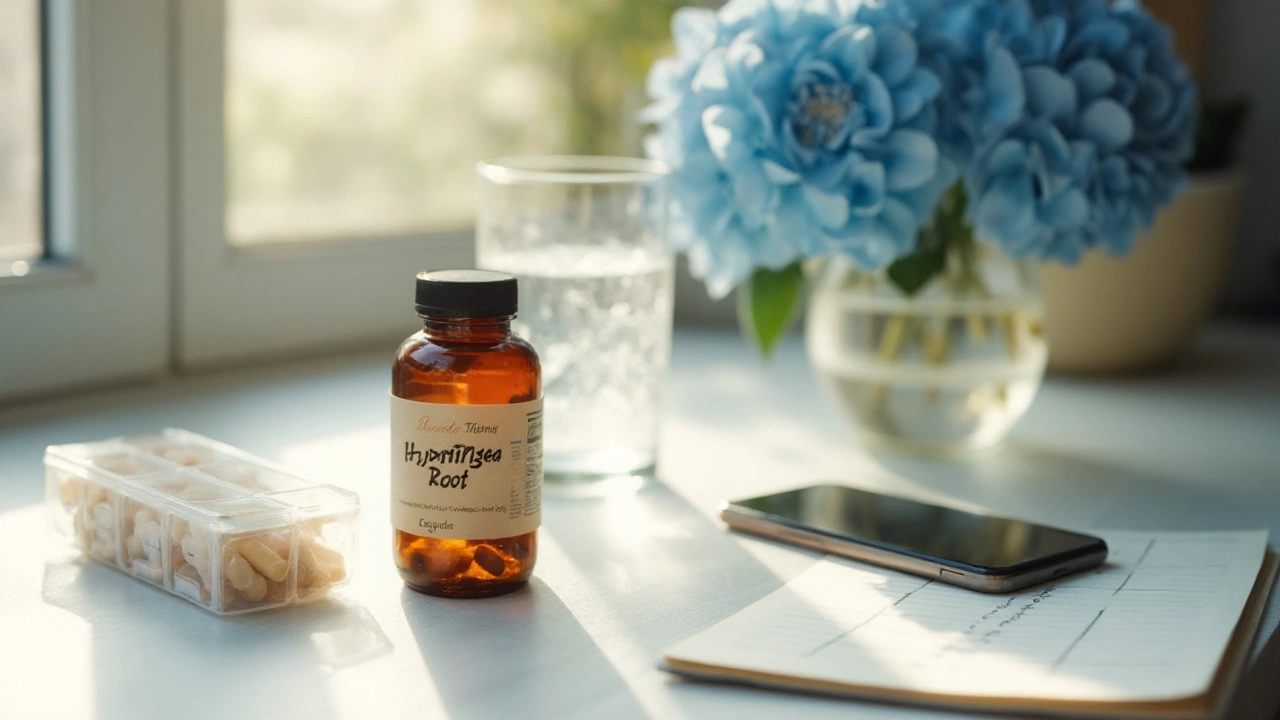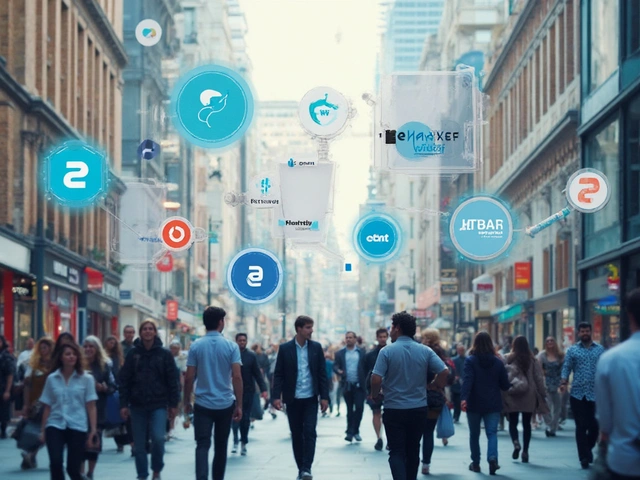If you’re curious whether a hydrangea supplement can help you feel lighter, move easier, or just take better care of your urinary tract, you’re in the right place. Here’s the straight talk: hydrangea has a long tradition in herbalism, but modern human studies are thin. You can use it as a gentle support, not a miracle fix. I’ll show you what it may (and may not) do, how to use it safely, and how to pick a product you can trust.
- TL;DR: Hydrangea is a traditional urinary and fluid-balance herb with limited human evidence. Expect subtle, supportive effects, not a cure.
- Best fit: Adults seeking gentle urinary comfort or bloat relief, who aren’t pregnant, nursing, or on diuretics/complex meds.
- Start low, go slow: Follow the label, test tolerance, hydrate well, and cycle use. Stop if you feel off.
- Safety first: Avoid DIY garden brews. Choose cGMP, third-party tested capsules or tinctures. Watch for GI upset.
- Proof check: As of August 2025, no robust randomized human trials. Most data are traditional use and animal/in vitro studies.
What Hydrangea Supplements Are (and What They Aren’t)
Quick primer so we’re talking about the same thing. When people say hydrangea supplement, they usually mean the root of Hydrangea arborescens, an herb used in North American folk practice for urinary comfort and fluid balance. You’ll also see Hydrangea serrata (leaves used in the Japanese “amacha” tea) and Hydrangea paniculata (studied in animals for kidney protection). These aren’t identical. Different species can contain different compounds and lead to different effects.
Key compounds include hydrangenol and phyllodulcin (a super-sweet molecule found in H. serrata). Extracts show antioxidant and mild diuretic activity in preclinical models. But here’s the catch: tradition doesn’t equal proof. As of 2025, I don’t see robust, peer-reviewed randomized human trials that confirm clear benefits in healthy adults or in people with specific conditions. The Natural Medicines database still tags hydrangea as “insufficient evidence” for most uses. That doesn’t make it useless-it just means we should keep expectations realistic.
What hydrangea is not: a treatment for kidney disease, urinary tract infections, or kidney stones. In the U.S., supplements can’t claim to diagnose, treat, cure, or prevent disease. The FDA doesn’t pre-approve supplements for efficacy. Companies can make “structure/function” claims (like “supports urinary comfort”) but must add a DSHEA disclaimer and be able to back up safety. Lean on that frame: supportive, not curative.
Also, don’t homebrew tea from your yard hydrangeas. Some ornamental parts contain cyanogenic glycosides. Case reports describe nausea and vomiting after people or pets nibble on hydrangea leaves or flowers. Stick to finished products meant for internal use, made by brands that test for purity and contaminants.
Potential Benefits and What to Expect
Why do people reach for a hydrangea supplement? Three main reasons: urinary comfort, feeling less puffy from fluid retention, and a general “clean, light” feeling during a short wellness reset. Let’s break down what’s plausible, what’s overhyped, and where the science sits today.
- Urinary comfort and flow support: Traditional use of H. arborescens root centers on easing mild urinary tract discomfort and supporting flow. Animal work with H. paniculata extracts suggests antioxidant and anti-inflammatory actions in kidney tissue (Journal of Ethnopharmacology, 2017). Human proof is not robust. If you notice anything, it’s usually a gentler, easier flow and less sense of cloudiness or heaviness.
- Fluid-balance support: Some users report feeling less puffy. That’s consistent with a mild diuretic effect seen in preclinical studies. If you tend to hold water after salty meals, you may notice a small difference, but don’t expect dramatic changes on the scale. Any water-weight shift will vanish if diet and hydration are off.
- Antioxidant support: Phyllodulcin and hydrangenol show antioxidant activity in lab settings (Food Chemistry, 2013; Free Radical Research, 2014). Antioxidants are great, but antioxidant findings in test tubes rarely map 1:1 to human outcomes. Consider this a nice-to-have, not a reason to buy on its own.
- Glucose or weight effects: A few mouse studies hint that phyllodulcin could help with metabolic markers (Food & Function, 2013). There are no solid human trials confirming weight loss or glucose control. Don’t pick hydrangea for weight management; invest in protein, fiber, and movement first.
Timing: People who feel benefits usually notice within 1-2 weeks of steady use. If you feel nothing by week four-and your sleep, salt intake, and hydration are dialed-hydrangea probably isn’t your tool.
Who tends to like it: folks who prefer gentle, traditional herbs; those who want something milder than caffeine or harsh diuretics; and people who already have good lifestyle basics and want a small extra nudge. Who gets disappointed: anyone expecting a fix for medical urinary issues, major weight shifts, or big performance boosts in the gym.
Evidence snapshot (as of August 2025):
- Human RCTs: none that are high-quality and published in major journals.
- Preclinical: multiple animal/in vitro papers on antioxidant/renal support (Journal of Ethnopharmacology, 2012-2019; Phytomedicine, 2016).
- Traditional use: documented for H. arborescens root in North American herbal practice; H. serrata leaf in East Asian tea (amacha).
- Authority notes: FDA does not pre-approve supplements; DSHEA governs claims. The NIH Office of Dietary Supplements lists many botanicals but has no dedicated monograph for hydrangea; safety/evidence are considered insufficient by several clinical databases.

Safe Use, Dosing, Side Effects, and Smart Pairings
Here’s a simple, safe way to test hydrangea without turning your routine upside down.
- Clear it with your clinician if you take meds or have a condition. Especially if you use diuretics, lithium, or have kidney issues, high blood pressure, or are pregnant/nursing.
- Pick the right form (capsule or tincture) from a cGMP brand with third-party testing (USP, NSF, Informed Choice). Avoid raw powders from unknown sellers.
- Start low: take the smallest label dose with a full glass of water for 3-4 days. Note how you feel-energy, bathroom trips, stomach, skin.
- Step up to the regular dose if you feel fine. Stick with it for 2-4 weeks. Stop if you notice dizziness, nausea, cramps, or rash.
- Cycle: after 6-8 weeks of steady use, take 2-4 weeks off. This helps you judge whether it’s doing anything and avoids taking herbs on autopilot.
Forms, typical amounts, and what to expect:
| Form | Typical Daily Amount (label-based) | Pros | Cons | Cost Range (USD) | Onset | Evidence Strength |
|---|---|---|---|---|---|---|
| Capsules (H. arborescens root powder or extract) | 500-1,000 mg, 1-2× daily | Easy dosing, travel-friendly | Not usually standardized | $12-$28/month | 7-14 days | Traditional + preclinical |
| Tincture (1:5 root in 40-60% alcohol) | 1-2 mL, 2-3× daily | Flexible dosing, rapid absorption | Taste/alcohol content | $14-$30/month | 3-7 days | Traditional + preclinical |
| Standardized extract (if available) | As per label; look for hydrangenol/phyllodulcin % if stated | Consistency batch to batch | Few brands standardize; pricier | $20-$40/month | 7-14 days | Traditional + preclinical |
Side effects and cautions:
- Common: mild nausea, loose stools, headache, more bathroom trips. Take with food and water.
- Allergy: rare. Stop if you get itching, swelling, or hives.
- Interactions: possible additive effects with diuretics (loop, thiazide). Use caution if on lithium (changes in fluid balance can affect levels). If you’re on multiple meds, ask your pharmacist.
- Do not use if pregnant or breastfeeding (lack of safety data). Not for kids.
- Kidney disease or history of stones: talk to your nephrologist. Avoid self-experimenting.
- Pets: hydrangea garden plants can be toxic to pets. Keep supplements out of reach.
Smart pairings (if your clinician is on board):
- For fluid balance: dandelion leaf or nettle leaf can pair well, but monitor bathroom frequency and electrolytes. Don’t stack multiple diuretic herbs without a plan.
- For urinary comfort: corn silk or marshmallow root for soothing mucosa. Hydrate well.
- For bloat tied to salt: magnesium glycinate at night and a potassium-rich diet (leafy greens, avocado) can help. Keep sodium under ~2,300 mg/day.
Hydration rules of thumb:
- Daily target: about 30-35 mL/kg body weight (check with your clinician if you have heart or kidney conditions).
- Color check: pale yellow urine usually means you’re in a good range.
How to Pick a Quality Product, Apply Checklists, and Get Answers
Not all bottles are equal. Here’s how to choose right and use it well.
Quality checklist (5-minute label audit):
- Latin name: Hydrangea arborescens (root). If it’s serrata or paniculata, the label should say why and what part is used.
- Part and form: “root,” “root extract,” or “tincture 1:5 root.” Avoid vague “hydrangea blend” without details.
- Company quality: cGMP mentioned; third-party testing badges like USP, NSF, or Informed Choice.
- Servings and dosage: clear daily amount. No “proprietary blend” hiding milligrams.
- Additives: simple excipients. Skip artificial dyes, sketchy fillers, or undeclared botanicals.
- Contact info: batch/lot number and a way to reach the brand if needed.
Fit decision tree (two-minute self-check):
- If you’re pregnant/nursing, under 18, or have kidney/heart issues → skip and talk to your clinician.
- If you take diuretics or lithium → ask your prescriber first.
- If you want a gentle urinary support and tolerate herbs well → consider a small trial.
- If you want weight loss or to treat UTIs/kidney stones → this is not the right tool.
Simple 2-4 week trial plan:
- Week 0 setup: keep your salt moderate, aim for 7-9 hours of sleep, and hit your water target. Start a quick note in your phone for energy, bathroom frequency, and bloat.
- Week 1: take the lowest label dose with breakfast for 3-4 days. If fine, move to the full label dose. No stacking yet.
- Week 2: if tolerated, optionally add one supportive herb (nettles or corn silk) or just keep it simple.
- End of Week 2-4: decide if you feel a clear benefit. If not, stop. If yes, continue to week 6-8, then cycle off 2-4 weeks.
Pitfalls to avoid:
- Using garden hydrangea to make tea. Don’t.
- Chasing fast water loss before a trip or event. Dehydration ruins your day.
- Ignoring salt intake. Supplements won’t cancel a high-sodium diet.
- Taking on an empty stomach if you get nausea. Eat first.
- Assuming “natural” means safe with your meds. Always check.
Real-world scenarios:
- Desk worker with afternoon bloat: You clean up lunch (more protein and greens, less chips), hit your water target, and test hydrangea for two weeks. You feel a touch lighter by week two. You keep it, but only on busy office days.
- Runner training in heat: You think about hydrangea for puffiness, but your coach warns about extra fluid loss. You skip it, add electrolytes, and focus on sodium timing. Good call.
- Parent on a thiazide diuretic: You like herbal options, but your pharmacist flags the overlap. You pass, and your care team adjusts your med dose instead.
Mini‑FAQ:
- Is hydrangea safe? In healthy adults using labeled doses from reputable brands, it’s usually well tolerated. Skip if pregnant, nursing, or on diuretics/lithium.
- How fast will I feel it? If it’s going to help, expect subtle changes in 1-2 weeks.
- Capsule or tincture? Capsules are easy; tinctures let you fine‑tune dose. Go with the form you’ll actually use daily.
- Can I take it every day? Many do short stints (6-8 weeks on, then 2-4 off). Long‑term daily use without breaks isn’t necessary for most people.
- What about kidney stones or UTIs? Don’t self‑treat. See your clinician. Hydrangea is not a fix for infections or stones.
- Will it help me lose weight? No. If the scale moves, it’s likely water, not fat. Focus on food quality, protein, fiber, and steps.
- Is there cyanide in hydrangeas? Some parts of ornamental plants have cyanogenic glycosides. That’s why we use finished supplements from tested sources-not DIY teas.
Next steps and troubleshooting:
- If you’re new to herbs: keep a simple log. If there’s no clear benefit at four weeks, stop and move on.
- If you feel jittery or dehydrated: you may be losing too much fluid. Cut the dose or stop, and add electrolytes.
- If you get stomach upset: take with food or switch forms (e.g., tincture to capsule). If it persists, stop.
- If you’re on meds: bring the supplement facts panel to your pharmacist. Ask about diuretic‑like effects and timing with your prescriptions.
- If you like the gentle lift: keep hydrangea for short windows-big travel weeks, higher‑salt holidays, or when you’re dialing nutrition and want a small push.
Bottom line: hydrangea can be a modest, traditional tool for urinary comfort and fluid balance, best used with smart habits-sleep, hydration, and sane salt intake. Go in with clear goals, track how you feel, and pick a tested product. If it helps, great. If not, there are plenty of other tools worth trying.




